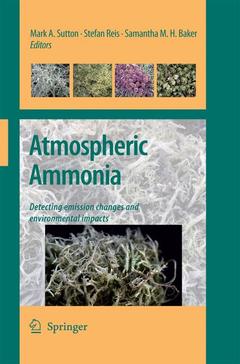Atmospheric Ammonia, 2009 Detecting emission changes and environmental impacts. Results of an Expert Workshop under the Convention on Long-range Transboundary Air Pollution
Coordonnateurs : Sutton Mark, Reis Stefan, Baker Samantha

Anthropogenic emissions of ammonia cause a host of environmental impacts, including loss of biodiversity, soil acidification and formation of particulate matter in the atmosphere. Under the auspices of the UNECE Convention on Long Range Transboundary Air Pollution, around 80 international experts met to review the state of scientific knowledge. This book reports their analysis. It concludes that threshold levels for ammonia effects have been underestimated and sets new values, it assesses the independent evidence to verify reported reductions in regional ammonia emissions, and it reviews the uncertainties in modelling ammonia, both in "hot spots" and at the regional scale.
Mark Sutton
Is a specialist in the behaviour of ammonia in the atmosphere, based at the NERC Centre for Ecology and Hydrology, Edinburgh. He is the coordinator of the NitroEurope Integrated Project, chairman of the European Centre of the International Nitrogen Initiative and co-chair of the UNECE Task Force on Reactive Nitrogen.
Stefan Reis
Is an expert on emissions of atmospheric pollutants and integrated assessment modelling. Formerly of the Institute of Energy Economics and the Rational Use of Energy at the University of Stuttgart, Germany, he is now the Scientific Project Manager of the NitroEurope Integrated Project.
Samantha Baker
Is a scientific policy analyst at the UK Department for Environment Food and Rural Affairs (Defra), with extensive experience of transboundary air pollution issues. She and a member of the Natural Resource and Rural Affairs (NRRA) Science Division at Defra and co-chairs the Projections Panel of the UNECE Task Force on Emission Inventories and Projections.
Explains the current state of knowledge of the behaviour of ammonia in the environment
Reports new critical level values
Date de parution : 09-2014
Ouvrage de 464 p.
15.5x23.5 cm
Disponible chez l'éditeur (délai d'approvisionnement : 15 jours).
Prix indicatif 158,24 €
Ajouter au panierDate de parution : 03-2009
Ouvrage de 464 p.
15.5x23.5 cm



